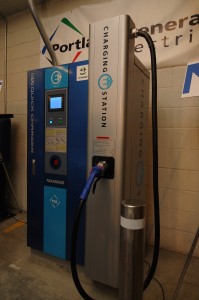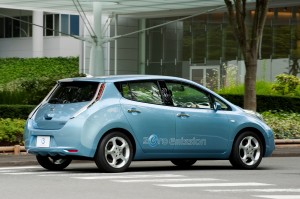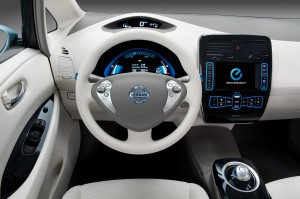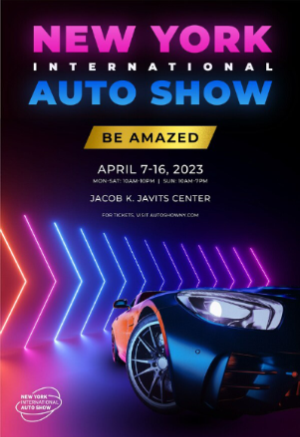 Portland, Ore — Portland General Electric (PGE) took an early lead in the electrification of the automobile when they opened North America?s first public-use quick-charge station in downtown Portland.? The on-street public charging station joined more than 30 private charging stations in the Portland region as of August 2010.
Portland, Ore — Portland General Electric (PGE) took an early lead in the electrification of the automobile when they opened North America?s first public-use quick-charge station in downtown Portland.? The on-street public charging station joined more than 30 private charging stations in the Portland region as of August 2010.
Currently most of the operating stations are used for corporate or government electric vehicles, but they are important parts of the electric link that will be needed as cars like the new Nissan Leaf and other electric vehicles become available to the public later this year.
This first public installation was done in partnership with NEC Corporation, a leading communications and information technology company.? The Takasago Rapid Charging Station used is a specialized unit for recharging electric vehicles with lithium-ion batteries. It requires only 20 to 30 minutes to recharge a battery to 80 percent of full strength.
 At the station dedication on August 5, Oregon Governor Ted Kulongoski said, ?Quick-charging stations are an exciting advancement in our effort to bring electric vehicles to Oregon.? By making charging convenient and available for public use, we are telling car manufacturers that Oregon is ready for the next generation of electric vehicles ? and we want our state to be a leader in introducing these cars to the rest of the country.?
At the station dedication on August 5, Oregon Governor Ted Kulongoski said, ?Quick-charging stations are an exciting advancement in our effort to bring electric vehicles to Oregon.? By making charging convenient and available for public use, we are telling car manufacturers that Oregon is ready for the next generation of electric vehicles ? and we want our state to be a leader in introducing these cars to the rest of the country.?
I had an opportunity to take a short test drive in the electric Nissan Leaf.? Often working prototypes like the Leaf are not quite finished or lack features, but this car was nearly customer ready.
The Leaf styling is contemporary and a bit futuristic, especially inside with the digital displays and controls that look like they are from a concept car.? Except for a little electric whine, the Leaf was practically silent.? Mark Perry, Director of Nissan Product Planning and Advance Technology Strategy, who was along with me on my drive, said they had to add some sounds as a safety measure to assure it could be heard coming.
 With the motor producing about 207-lb.ft. of instant torque, the Leaf accelerates from 0 to 60 mph in an estimated the 9 to 10 seconds but feels much faster.
With the motor producing about 207-lb.ft. of instant torque, the Leaf accelerates from 0 to 60 mph in an estimated the 9 to 10 seconds but feels much faster.
A little on the soft side, the ride is almost plush.? The softness translates to some body roll when cornering, but if feels natural.? I like the tight turning radius and agility ? it is a fun car to drive.
The standard Leaf has a sophisticated computer and navigation system that gives the driver all sorts of stats about the vehicle performance including the big one ? how far can I go?? Pressing a button on the navigation system Perry showed a map with concentric circles around our location indicating the range of the Leaf, based on the remaining charge.
When I drove, the range was 84 miles ? at full charge the ?book? says it will go about 100 miles, of course it depends on how frugal the driver is with the power.? My wife, Barbara, would do better than most drivers because she avoids jackrabbit starts and unnecessary passing.? I don?t understand where the numbers come from, because there are no gallons for electric cars, but estimates say it gets the equivalent of 367 mpg.
The Manufacturer?s Suggested Retail Price *(MSRP) for the 2011 all-electric, zero-emission Nissan Leaf is $32,780, which includes three years of roadside assistance.?Additionally, there is an array of state and local incentives that may further defray the costs and increase the benefits of owning a Nissan Leaf ? such as a $5,000 statewide tax rebate in California; a $5,000 tax credit in Georgia; a $1,500 tax credit in Oregon; and carpool-lane access in some states, including California.? Nearly 17,000 potential owners have written $99 (refundable) checks to get their name on the list to buy a Leaf in December.
Nissan Leaf will be available first to consumers in December, in California, Washington, Oregon, Arizona and Tennessee.








